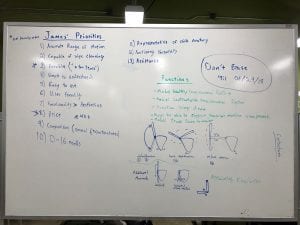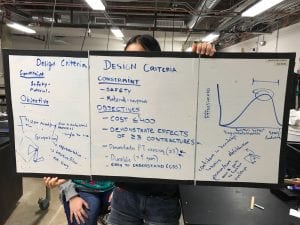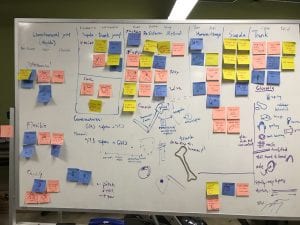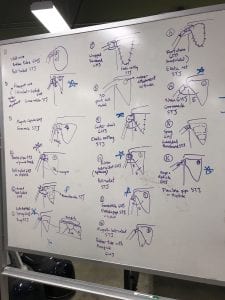We spent most of this week enduring the storms. I don’t mean thunderstorms or ice storms – here in Houston, it’s as hot and oven-like as ever. No, I mean BRAINstorms. Weathering through these storms is a test of cognitive endurance. We had forecasted them a long time ago and had no choice but to grab our sticky notes and face them head-on.
To prepare for all of that though, we had to collect supplies and reinforcements. My team, Can’t Brachius, spent the early part of this week on research. On Monday, we gave the people at SEED a mini-lesson on anatomical directions and shoulder motions during the morning meeting, followed by a quiz at the end. Though we can’t hope that everyone got a perfect score, our lesson was a good way to get everyone warmed up and ready for the day! For the remainder of Monday, we continued our Design Context Review (DCR), a set of guidelines and topics that helps engineering teams organize their research. We dug through even more medical and anatomical articles until our research document was entirely covered with anatomical drawings of shoulders. At the suggestion of the rest of SEED, we even looked into devices like bendy straws and the flexible necks of desk lamps (called “goose-necks”), which might help us create the mechanism for our moveable shoulder joint.
By Tuesday afternoon, we took a break from research and moved onto establishing and ranking the design criteria for our project. Though some of the criteria (safety, cost, durability) were simple to define, the others gave us a surprising amount of difficulty. The seemingly endless list of features and functions that our device should include initially overwhelmed us – how were we supposed to consolidate all of them into 2-3 objectives?? What followed was the most intense and in-depth debate about design criteria I had ever experienced. Though mentally draining, that debate allowed us to clarify our common goals moving forward. We agreed that since our project was an educational model, it was most important that our device be easy to understand so that parents feel comfortable performing the physical therapy exercises and understanding the shoulder contractures after using the device.
With our priorities established, our team spent the entirety of Wednesday brainstorming solutions and categorizing them into design blocks (scapula-humerus attachment, scapula-trunk attachment, etc.). We wrote each idea on sticky notes and ended up with over 80 total ideas. We ran into another roadblock while trying to morph our separate ideas into complete solutions. It turns out, the shoulder is a very complicated body part with many interdependent components. Though brainstorming each component separately isn’t that bad, thinking about how the components combine together proved to be immensely annoying. Visualizing just one possible combination took us over 30 minutes. At that point, we were stalled and frustrated.
Three actions propelled us forward:
First, we created a glossary of mechanical words (“spring”, “elastic”, “pulley”) and drawings. Because Brazilian English classes wouldn’t teach obscure and specific words like those, it was sometimes hard for Rebeca to picture the mechanisms described in some of the brainstorming ideas. It was impossible for everyone to understand each idea without establishing a shared vocabulary.
Second, we prescreened each design block using common sense and eliminated many unfeasible ideas. The prescreening allowed us to further categorize the ideas, simplifying the morphing process.
Third, we discovered the OEDK popcorn machine. Popcorn has magical restorative properties. I will add a picture next week.
On Friday, we finally began to combine ideas into full solutions. It took us the whole day to create 16 plausible, complete solutions. Next week, we plan to finish screening/scoring solutions to select one final solution. This week was rather mentally exhausting, and next week will be a grind as well. As the saying goes, after every storm is a rainbow. Once all this screening and scoring is over, I’m more excited than ever to see what we come up with! Until next time.




